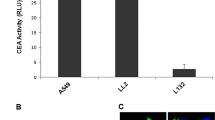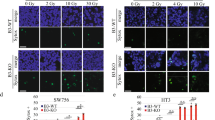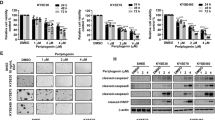Abstract
The purpose of this study is to develop a specific and efficient targeted gene therapy candidate approach for laryngeal carcinomas. Several promoters of human squamous cell carcinoma antigen 2(SCCA2), secretory leukocyte protease inhibitor (SLPI) and Survivin genes were cloned from human genomic DNA and evaluated for tumor-specific transcription potential in human laryngeal carcinoma Hep-2 cells by dual luciferase assays. One SLPI promoter fragment (677 bp) showed the highest efficiency and specificity, and was used to control the expression of a recombinant active caspases-3 (revCasp3), which could trigger apoptosis without activation of its upstream cascade elements once expressed in a cell, in an adenoviral vector (Ad-SLPI-revCasp3), and its antitumor efficacy was assessed. In vitro infection with Ad-SLPI-revCasp3 showed revCasp3 could be specifically expressed in Hep-2 cells, resulting in efficient activation of endogenous Caspase-3 and subsequent apoptosis of Hep-2 cells. In Hep-2 nude mice xenograft model, intratumoral administration of Ad-SLPI-revCasp3 significantly inhibited tumor growth without obvious loss of body weight and obvious hepatic toxicity. In summary, our study showed the specific and efficient apoptosis-inducing potential of Ad-SLPI-revCasp3, and this makes it a new candidate approach of targeted gene therapy for laryngeal squamous cell carcinoma, which needs further systematic investigation.
This is a preview of subscription content, access via your institution
Access options
Subscribe to this journal
Receive 12 print issues and online access
$259.00 per year
only $21.58 per issue
Buy this article
- Purchase on Springer Link
- Instant access to full article PDF
Prices may be subject to local taxes which are calculated during checkout






Similar content being viewed by others
References
Surveillance, epidemiology and end results program web site. Available at URL: http://seer.cancer.gov/statfacts/html/laryn.html; accessed May 1st, 2011.
Nakano H, Kishida T, Asada H, Shin-Ya M, Shinomiya T, Imanishi J et al. Interleukin-21 triggers both cellular and humoral immune responses leading to therapeutic antitumor effects against head and neck squamous cell carcinoma. J Gene Med 2006; 8: 90–99.
Saukkonen K, Hemminki A . Tissue-specific promoters for cancer gene therapy. Expert Opin Biol Ther 2004; 4: 683–696.
Barker SD, Coolidge CJ, Kanerva A, Hakkarainen T, Yamamoto M, Liu B et al. The secretory leukoprotease inhibitor (SLPI) promoter for ovarian cancer gene therapy. J Gene Med 2003; 5: 300–310.
Oshikiri T, Miyamoto M, Hiraoka K, Shichinohe T, Kawarada Y, Kato K et al. Transcriptional targeting of adenovirus vectors with the squamous cell carcinoma-specific antigen-2 promoter for selective apoptosis induction in lung cancer. Cancer Gene Ther 2006; 13: 856–886.
Murakami A, Suminami Y, Sakaguchi Y, Nawata S, Numa F, Kishi F et al. Specific detection and quantitation of SCC antigen 1 and SCC antigen 2 mRNAs by fluorescence-based asymmetric semi-nested reverse transcription PCR. Tumour Biol 2000; 21: 224–234.
Abe T, Tominaga Y, Kikuchi T, Watanabe A, Satoh K, Watanabe Y et al. Bacterial pneumonia causes augmented expression of the secretory leukoprotease inhibitor gene in the murine lung. Am J Respir Crit Care Med 1997; 156: 1235–1240.
Dasgupta S, Tripathi PK, Qin H, Bhattacharya-Chatterjee M, Valentino J, Chatterjee SK . Identification of molecular targets for immunotherapy of patients with head and neck squamous cell carcinoma. Oral Oncol 2006; 42: 306–316.
Srinivasula SM, Ahmad M, MacFarlane M, Luo Z, Huang Z, Fernandes-Alnemri T . Generation of constitutively active recombinant caspases-3 and -6 by rearrangement of their subunits. J Biol Chem 1998; 273: 10107–10111.
Cam L, Boucquey A, Coulomb-L’hermine A, Weber A, Horellou P . Gene transfer of constitutively active caspase-3 induces apoptosis in a human hepatoma cell line. J Gene Med 2005; 7: 30–38.
Kikuchi T, Abe T, Satoh K, Narumi K, Sakai T, Abe S et al. Cis-acting region associated with lung cell-specific expression of the secretory leukoprotease inhibitor gene. Am J Respir Cell Mol Biol 1997; 17: 361–367.
Li F, Altieri DC . Transcriptional analysis of human survivin gene expression. Biochem J 1999; 2: 305–311.
Jonsson N, Gullberg M, Israelsson S, Lindberg AM . A rapid and efficient method for studies of virus interaction at the host cell surface using enteroviruses and real-time PCR. Virol J 2009; 6: 217.
Glasgow JN, Everts M, Curiel DT . Transductional targeting of adenovirus vectors for gene therapy. Cancer Gene Ther 2006; 13: 830–844.
Willhauck MJ, Sharif Samani BR, Klutz K, Cengic N, Wolf I, Mohr L et al. Alpha-fetoprotein promoter-targeted sodium iodide symporter gene therapy of hepatocellular carcinoma. Gene Ther 2007; 15: 214–223.
Rein DT, Breidenbach M, Curiel DT . Current developments in adenovirus-based cancer gene therapy. Future Oncol 2006; 2: 137–143.
Wang Z, Sun Y . Targeting p53 for novel anticancer therapy. Transl Oncol 2010; 3: 1–12.
Oh YK, Park TG . siRNA delivery systems for cancer treatment. Adv Drug Deliv Rev 2009; 61: 850–862.
Mossoba ME, Medin JA . Cancer immunotherapy using virally transduced dendritic cells: animal studies and human clinical trials. Expert Rev Vaccines 2006; 5: 717–732.
Portsmouth D, Hlavaty J, Renner M . Suicide genes for cancer therapy. Mol Aspects Med 2007; 28: 4–41.
Peng Z . Current status of gendicine in China: recombinant human Ad-p53 agent for treatment of cancers. Hum Gene Ther 2005; 16: 1016–1027.
Xian J, Lin Y, Liu Y, Gong P, Liu S . Combined p14ARF and antisense EGFR potentiate the efficacy of adenovirus-mediated gene therapy in laryngeal squamous cell carcinoma (LSCC). DNA Cell Biol 2007; 26: 71–79.
Hamstra DA, Rice DJ, Fahmy S, Ross BD, Rehemtulla A . Enzyme/prodrug therapy for head and neck cancer using a catalytically superior cytosine deaminase. Hum Gene Ther 1999; 10: 1993–2003.
Heilbronn R, Weger S . Viral vectors for gene transfer: current status of gene therapeutics. Handb Exp Pharmacol 2010; 197: 143–170.
Caldas H, Jaynes FO, Boyer MW, Hammond S, Altura RA . Survivin and Granzyme B-induced apoptosis, a novel anticancer therapy. Mol Cancer Ther 2006; 5: 693–703.
Lorenzo HK, Susin SA . Therapeutic potential of AIF-mediated caspase-independent programmed cell death. Drug Resist Updat 2007; 10: 235–255.
Gross A . BID as a double agent in cell life and death. Cell Cycle 2006; 5: 582–584.
Weiwei M, Zhenhua X, Feng L, Hang N, Yuyang J . A significant increase of RNAi efficiency in human cells by the CMV enhancer with a tRNAlys promoter. J Biomed Biotechnol 2009; 2009: 514287.
Curiel DT . The development of conditionally replicative adenoviruses for cancer therapy. Clin Cancer Res 2000; 6: 3395–3399.
Jiang H, Gomez-Manzano C, Lang FF, Alemany R, Fueyo J . Oncolytic adenovirus: preclinical and clinical studies in patients with human malignant gliomas. Curr Gene Ther 2009; 9: 422–427.
Yang ZR, Wang HF, Zhao J, Peng YY, Wang J, Guinn BA . Recent developments in the use of adenoviruses and immunotoxins in cancer gene therapy. Cancer Gene Ther 2007; 14: 599–615.
Acknowledgements
The work was supported by grants from the Department of Public Health of Zhejiang Province of China (No. 2008A089, No. 2009A102 and No. 2007A086), Department of Science and Technology of Zhejiang Province (No. 2008F1029) and Department of Education of Zhejiang Province (Y200804137). We thank Ms Yuelan Chen for her technical assistance in the work.
Author information
Authors and Affiliations
Corresponding authors
Ethics declarations
Competing interests
The authors declare no conflict of interest.
Rights and permissions
About this article
Cite this article
Chen, J., Yang, B., Zhang, S. et al. Antitumor potential of SLPI promoter controlled recombinant caspase-3 expression in laryngeal carcinoma. Cancer Gene Ther 19, 328–335 (2012). https://doi.org/10.1038/cgt.2012.5
Received:
Revised:
Accepted:
Published:
Issue Date:
DOI: https://doi.org/10.1038/cgt.2012.5
Keywords
This article is cited by
-
Antitumor Efficacy of SLPI Promoter-Controlled Expression of Artificial microRNA Targeting EGFR in a Squamous Cell Carcinoma Cell Line
Pathology & Oncology Research (2017)
-
DNA Polymerases as targets for gene therapy of hepatocellular carcinoma
BMC Cancer (2015)
-
Contribution of TIP30 to chemoresistance in laryngeal carcinoma
Cell Death & Disease (2014)
-
Alpha B-crystallin is a new prognostic marker for laryngeal squamous cell carcinoma
Journal of Experimental & Clinical Cancer Research (2012)



